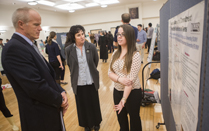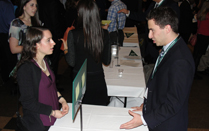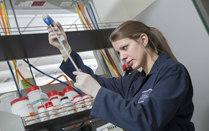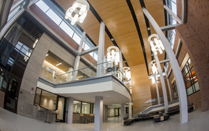Binghamton University President Harvey Stenger's Quarterly Report - March 31, 2014
There is always a palpable sense of excitement and energy on campus when springtime finally comes to Binghamton University. This is especially true this year, given that we have had one of the hardest, longest and coldest winters on record. I want to commend the workers in our Physical Facilities Department for their hard work over the past few months to keep the campus clear of snow and ice.
Despite the rigors of the season, Binghamton University has remained a very busy place, with lectures, sporting events, concerts and plays to challenge, entertain and inspire the University community during the dreary days of winter. Meanwhile, our faculty and staff have been working to ensure that we continue to meet the needs of our students, our community and our state. We are moving ahead with ambitious plans to expand the University through increased enrollment, new academic programs, additional faculty, and new facilities and campus services that are responsive to the needs of today’s students, faculty and alumni and that will serve us well as we travel our Road Map to Premier.
While we spent much of the past quarter looking to the future, we also recognized the contributions of one of our previous leaders, President Clifford Clark, who died in January at the age of 88. Clark was president at Binghamton for 16 years, from 1975 until 1989, and left a lasting legacy. In particular, he played a significant role in developing our graduate programs and establishing and strengthening the Watson School and the Decker School of Nursing. He also was deeply committed to enhancing campus diversity and inclusivity ─ laudable goals that are as important today as they were during President Clark’s tenure ─ and it is important to recognize his visionary leadership.
In the same way, the University has benefited from having a comprehensive Road Map and a strong University community. This Quarterly Report will showcase our progress on implementing our Road Map and highlight some of the projects that will help position the University for the coming decade. In addition, it will briefly discuss some of the many interesting, educational and just plain fun events that took place this winter.
On a personal note, the harsh winter wreaked havoc on my daily run through campus. As a substitute, I have been playing hockey in a local community league. Perhaps because I am not as nimble as I used to be (the perils of getting older), I have learned the value of preparation and having a broad view of the ice. Being in the right place, at the right time, with a good team behind you is crucial to being able to take advantage of scoring opportunities.
Road Map
We are moving forward on a number of projects identified as Road Map priorities. Our Road Map Steering Committee has been divided into five teams corresponding to our five strategic priorities — creative activities, learning community, inclusive campus, global impact and strategic investments. These teams are developing metrics to assess our progress on the 46 projects funded this year. These metrics include both leading and lagging indicators that will allow us to determine whether our goals are being met. Each team will devise criteria for assessment of their own strategic priority, and share them among the teams so that we can ensure the quality of our metrics across all priorities.
At the same time, we are looking forward to 2015-16, and Provost Donald Nieman has announced a request for proposals. An original deadline of April 7 has been extended through May 1, though faculty and staff are encouraged to submit earlier rather than later. Once received, the proposals will be refined by the Road Map Steering Committee, reviewed by the Faculty Senate Budget Committee and ranked by the Steering Committee. Final decisions will be made by mid-summer.
I discussed the progress we’ve made on our Road Map at the annual “State of the University” in January. This year my address was held during the week that students returned to campus so that more students and faculty would be able to attend and comment. Apparently this was a good idea, since the Anderson Center’s 1,200-seat Osterhout Concert Theater was filled nearly to capacity — about three times more people were able to attend than in previous years.
Pharmacy School
At the State of the University, I described the progress we’ve made toward establishing our new School of Pharmacy and Pharmaceutical Sciences. In my last Quarterly Report, I explained that we had submitted a letter of intent to SUNY to create a new Doctor of Pharmacy degree program. We’ve now developed a full proposal that has recently been approved by our Faculty Senate. Our next step is to submit this to SUNY and the State Education Department, which will be done by early summer. We are not expecting any major hurdles in this process. I am excited about this program, as it will bring enormous benefits to the University, our local economy and the patients in our region’s health facilities.
Over the next seven years, as the facility is built and brought online, we expect that its annual economic impact will be over $219 million regionally and more than $290 million statewide. In addition, the school will support (directly and indirectly) over 2,428 jobs in New York state over the next few years, while providing much-needed professional training for students in a high-demand field. When fully enrolled, we expect 240 students in the DPharm program, plus an additional 60 students in a PhD program. We will hire 12 new clinical faculty to teach them, and bring on a dozen new research faculty as well. Each researcher should attract between $300,000 and $500,000 a year in external funding and we expect to see new and established drug companies and medical technology firms setting roots in the area, as these research faculty develop marketable products and technologies.
One of the questions we’ve been working to address is the siting of the new school. Our original plan was to modify some buildings on campus — an affordable but far from ideal approach, given the buildings’ original purposes and a general shortage of research space on campus. Thus, when the opportunity was presented to us in late December 2013 to plan a new building in Johnson City near UHS’s Wilson Hospital, we were very excited. As this report goes to print, we’ve learned that the legislature and governor have agreed to allocate $10 million to acquire the building site and begin design work. All told, the cost of the facility should be around $60 million, and be completed in 2017, just in time for its first cohort of graduate students.
Enrollment growth and 4-1-1
In the two years that I’ve been at Binghamton, I’ve consistently beat the drum for University growth. Growth is important for a number of reasons — it will serve as a catalyst for research, increase our visibility, contribute to educational excellence, and generate pride among alumni and other supporters. During my remarks at January’s State of the University, I stressed the importance of continued growth, noting that our peer institutions are significantly larger than we are, and more importantly, have a higher ratio of graduate to undergraduate students — on the average of 1:3, compared to our 1:5.
Fortunately, through the resources made available from NYSUNY 2020 and predictable tuition, we’ve been able to grow our enrollment (and our faculty) significantly over the past two years. Enrollment is on track to reach 17,000 by 2016. It is also important to note that over the past two years, we’ve added 93 new faculty with an additional 55 coming to campus next year. With March marking the height of the admissions season, we are confident that our goals for continued enrollment growth will be met. Looking to the future, I have set an enrollment target of 20,000 by 2020 — an ambitious but manageable target.
I am especially interested in seeing growth in our graduate enrollment to bring us more in line with our peer institutions. Already, we have several initiatives under way to attract more graduates, and signs point to their success — graduate applications this year are 20 percent higher than last year’s record number, and we are projecting an increase in graduate enrollment of 125. But even with this increase, we will barely alter our balance between undergraduate and graduate enrollments. So, in my State of the University, I proposed a major new program to attract master’s-level students to Binghamton — a 4-1-1 program that will give these students a significant advantage as they enter the workplace.
This program will offer credit-bearing externships to the University’s best graduating seniors, giving them work experience in a variety of businesses and organizations. Many professional schools already have similar programs — our goal is to open this program to students from all disciplines. I have established a task force, led by Susan Strehle, dean of the Graduate School, to develop a pilot program to start this coming fall. The challenge for us will be to establish new partnerships with organizations — we will of course draw on existing relationships — but will need to significantly expand them. I am especially interested in engaging our alumni in this project.
Campus lectures
As a university, and especially as a public university, we have an educational duty to provide opportunities for students and our community to hear from recognized thought leaders and to encourage public debate on a range of issues. This semester has seen a wide range of speakers addressing an equally diverse set of topics, beginning with a January event with Susquehanna International Group, LLP founding partner and managing director Jeff Yass, Class of ’79. Yass met with current and former Zurack Scholars in our School of Management, discussing the challenges of trying to beat the financial markets, which have the combined intellect of millions of individual investors.
Students also had the opportunity to hear from Alexis Ohanian, co-founder of Reddit, who gave an insightful talk on the creative process and its role in shaping the future of the Internet. Other lectures on campus have included ESPN analyst Stephen Smith; Professor David Cohen, who teaches secured finance and bankruptcy at Pace University School of Law; and bioethicist Jonathan Moreno, who gave the keynote address at the University’s Research Days celebration, discussing the morality of using neuroscience to build a more effective military.
In March, we were pleased to host the Third Annual TedX event at Binghamton University. This event, organized by students with support from University staff, brought together seven different speakers who spoke about the need to “Stray the Course.” Among the speakers for this sold-out event were mathematician and complexity scientist Hannah Fry, who spoke about the “The Mathematics of Love;” editor, columnist and website founder Anna Holmes, who discussed “The Birth of Jezebel,” and the relationship between gender politics and pop culture; as well as actor, writer, director and alumnus Ruben Santiago-Hudson ’78, who told students to “Stray the Path” — addressing the need to conform to rules while developing as an individual.
While the audience at most of these events was comprised largely of members of the campus community, the University often reaches out to residents of the surrounding towns and villages, giving them the opportunity to participate in conferences and seminars on issues of concern to the local community. Most recently, the Binghamton University Forum (formerly the Harpur Forum) presented a panel discussion on the impact of the Affordable Care Act. The panelists included Susan Arbetter, host of the leading New York state political radio program, “The Capitol Pressroom,” who moderated the event; James Tallon, president of the United Hospital Fund of New York; Kyle Brittingham, director of the Small Business Assistance Program; and Jeff Davis, a health policy consultant. In my opening remarks, I highlighted the many areas of University research where our faculty are helping to save lives through new medical technologies, reducing costs through greater efficiencies and bettering outcomes through the training of highly qualified nurses.
Our efforts to reach out to the community also involved showcasing Binghamton’s educational excellence and community impact at our annual “Binghamton University Day at the Oakdale Mall” last month. More than 1,500 community members stopped by to learn more about the campus, participate in interactive science experiments, watch performances by student organizations, and talk to professors and admissions staff about our academic programs and civic engagement. It was a high-energy, productive day, and I’m certain that a number of those who stopped by — or their sons or daughters — will someday be enrolled at Binghamton.
We also took our educational activities to Albany, where we provided information for legislators and their staffs as they prepared to finalize the state budget. In the past, we organized a large group of faculty, staff, administrators, students and community members — two buses worth — to overwhelm Albany for a day-long deluge of Binghamtonians. This year, contrary to what I usually say, we thought “Smaller is Better.
A more manageable group of us — in minivans, not buses — held court at the Legislative Office building. In addition to myself, advocates included Vice President for Research Bahgat Sammakia, United University Professions Chapter President Benita Roth, CSEA Chapter Vice President Martin Honeychuck, and University tour guide and BU Zoo co-president Ben Zachs, along with members of our communications and admissions teams. We encouraged passersby to tell us of their connections to Binghamton, while others provided information to legislators and their staffs. This newer format paid almost immediate dividends, as I had the opportunity to meet with Senator Ken LaValle, chair of the Senate Higher Education Committee, Lt. Gov. Robert Duffy, and others interested in Binghamton’s role as an educational and economic engine in the region. Meetings were very successful and I believe they helped shape the outcome of the recently completed budget negotiations in Albany.
And speaking of Albany, in mid-March, Binghamton University also hosted a Disaster Preparedness event that included, among the more than 450 community members who attended, a special visitor — Gov. Andrew Cuomo. He was here to stress the need for disaster education, so that community residents can be prepared for the next Hurricane Sandy or Tropical Storm Irene, both of which caused billions of dollars in damage to New York state communities. The Events Center was a very appropriate place to hold the event, since it had served as temporary housing for thousands of evacuees during the previous two floods that hit the region in 2006 and 2011.
Sincerely,

Harvey G. Stenger






